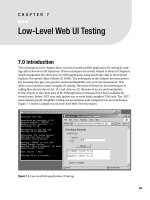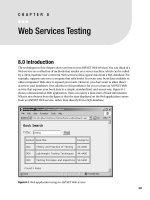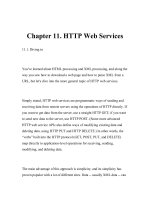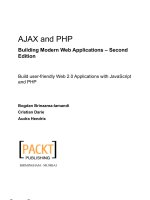11 modern web penetration testing
Bạn đang xem bản rút gọn của tài liệu. Xem và tải ngay bản đầy đủ của tài liệu tại đây (15.22 MB, 298 trang )
[1]
Mastering Modern Web
Penetration Testing
Master the art of conducting modern pen testing attacks
and techniques on your web application before the
hacker does!
Prakhar Prasad
BIRMINGHAM - MUMBAI
Mastering Modern Web Penetration Testing
Copyright © 2016 Packt Publishing
All rights reserved. No part of this book may be reproduced, stored in a retrieval
system, or transmitted in any form or by any means, without the prior written
permission of the publisher, except in the case of brief quotations embedded in
critical articles or reviews.
Every effort has been made in the preparation of this book to ensure the accuracy
of the information presented. However, the information contained in this book is
sold without warranty, either express or implied. Neither the author, nor Packt
Publishing, and its dealers and distributors will be held liable for any damages
caused or alleged to be caused directly or indirectly by this book.
Packt Publishing has endeavored to provide trademark information about all of the
companies and products mentioned in this book by the appropriate use of capitals.
However, Packt Publishing cannot guarantee the accuracy of this information.
First published: October 2016
Production reference: 1251016
Published by Packt Publishing Ltd.
Livery Place
35 Livery Street
Birmingham B3 2PB, UK.
ISBN 978-1-78528-458-8
www.packtpub.com
Credits
Author
Prakhar Prasad
Reviewer
Kubilay Onur Gungor
Commissioning Editor
Julian Ursell
Acquisition Editor
Rahul Nair
Content Development Editor
Amrita Noronha
Technical Editors
Manthan Raja
Copy Editor
Safis Editing
Project Coordinator
Shweta H Birwatkar
Proofreader
Safis Editing
Indexer
Mariammal Chettiyar
Graphics
Disha Haria
Production Coordinator
Arvindkumar Gupta
Cover Work
Arvindkumar Gupta
About the Author
Prakhar Prasad is a web application security researcher and penetration tester
from India. He has been a successful participant in various bug bounty programs
and has discovered security flaws on websites such as Google, Facebook, Twitter,
PayPal, Slack, and many more. He secured the tenth position worldwide in the year
2014 at HackerOne's platform. He is OSCP and OSWP certified, which are some of
the most widely respected certifications in the information security industry. He
occasionally performs training and security assessment for various government,
non-government, and educational organizations.
I am thankful from the bottom of my heart to the editors of this
book, Kajal Thapar, Amrita Noronha, and Manthan Raja, for helping
and assisting me at various stages of this book. The kick starter
behind this book is my dear friend Rafay Baloch, a known name in
the ethical-hacking community; he has been a constant source of
encouragement and motivation.
The last chapter of this book on API testing is written entirely by
Pranav Hivarekar, a renowned researcher in the domain of web
application security, who is a very good friend of mine and a downto-earth human being. I'm immensely thankful to him for coming up
with and authoring a guest chapter for this book.
I'll do injustice if I don't mention my family, friends, and loved ones,
who have always worked behind the scenes to keep me pumped up
and motivated at different stages of this book. This book wouldn't be
possible without their efforts.
About the Reviewer
Kubilay Onur Gungor has been working in the cyber security field for more than
8 years. He started his professional career with crypt analysis of encrypted images
using chaotic logistic maps.
After working as a QA tester in the Netsparker project, he continued his career in the
penetration testing field. He performed many penetration tests and consultancies for
the IT infrastructure of many large clients, such as banks, government institutions,
and telecommunication companies. After pen testing activities, he worked as a web
application security expert and incident management and response expert in Sony
Europe and Global Sony Electronics.
He believes in multidisciplinary approach on cyber security and defines it as
a struggle. With this approach, he has developed his own unique certification
and training program, including penetration testing, malware analysis, incident
management and response, cyber terrorism, criminal profiling, unorthodox methods,
perception management, and international relations. Currently, this certification
program is up and running in Istanbul in the name of Cyber Struggle
().
Besides security, he holds certificates in foreign policy, brand management, surviving
in extreme conditions, international cyber conflicts, anti-terrorism accreditation board,
terrorism and counter-terrorism comparing studies.
www.PacktPub.com
eBooks, discount offers, and more
Did you know that Packt offers eBook versions of every book published, with PDF
and ePub files available? You can upgrade to the eBook version at www.PacktPub.com
and as a print book customer, you are entitled to a discount on the eBook copy. Get in
touch with us at for more details.
At www.PacktPub.com, you can also read a collection of free technical articles, sign
up for a range of free newsletters and receive exclusive discounts and offers on Packt
books and eBooks.
/>
Get the most in-demand software skills with Mapt. Mapt gives you full access to all
Packt books and video courses, as well as industry-leading tools to help you plan
your personal development and advance your career.
Why subscribe?
• Fully searchable across every book published by Packt
• Copy and paste, print, and bookmark content
• On demand and accessible via a web browser
Table of Contents
Prefaceix
Chapter 1: Common Security Protocols
1
SOP1
Demonstration of the same-origin policy in Google Chrome
2
Switching origins
3
Quirks with Internet Explorer
4
Cross-domain messaging
4
AJAX and the same-origin policy
5
CORS6
CORS headers
7
Pre-flight request
7
Simple request
8
URL encoding – percent encoding
8
Unrestricted characters
9
Restricted characters
9
Encoding table
10
Encoding unrestricted characters
11
Double encoding
11
Introducing double encoding
11
IIS 5.0 directory traversal code execution – CVE-2001-0333
12
Using double encoding to evade XSS filters
13
Base64 encoding
14
Character set of Base64 encoding
14
The encoding process
15
Padding in Base64
16
Summary17
[i]
Table of Contents
Chapter 2: Information Gathering
19
Chapter 3: Cross-Site Scripting
51
Information gathering techniques
19
Active techniques
20
Passive techniques
20
Enumerating Domains, Files, and Resources
20
Fierce21
theHarvester26
SubBrute27
CeWL28
DirBuster30
WhatWeb32
Maltego32
Wolfram Alpha
36
Shodan37
DNSdumpster41
Reverse IP Lookup – YouGetSignal
42
Pentest-Tools
43
Google Advanced Search
43
Summary49
Reflected XSS
Demonstrating reflected XSS vulnerability
Reflected XSS – case study 1
Reflected XSS – case study 2
Stored XSS
Demonstrating stored XSS
Stored XSS through Markdown
Stored XSS through APIs
Stored XSS through spoofed IP addresses
Flash-based XSS – ExternalInterface.call()
HttpOnly and secure cookie flags
DOM-based XSS
XSS exploitation – The BeEF
Setting Up BeEF
Demonstration of the BeEF hook and its components
52
52
53
55
58
58
60
61
64
67
70
71
74
74
76
Logs78
Commands78
Rider
80
Xssrays
80
IPec
80
Network
81
Summary81
[ ii ]
Table of Contents
Chapter 4: Cross-Site Request Forgery
83
Introducing CSRF
84
Exploiting POST-request based CSRF
86
How developers prevent CSRF?
86
PayPal's CSRF vulnerability to change phone numbers
87
Exploiting CSRF in JSON requests
90
Using XSS to steal anti-CSRF tokens
92
Exploring pseudo anti-CSRF tokens
93
Flash comes to the rescue
94
Rosetta Flash
97
Defeating XMLHTTPRequest-based CSRF protection
98
Summary99
Chapter 5: Exploiting SQL Injection
101
Installation of SQLMap under Kali Linux
102
Introduction to SQLMap
103
Injection techniques
106
Dumping the data – in an error-based scenario
107
Interacting with the wizard
110
Dump everything!
112
SQLMap and URL rewriting
112
Speeding up the process!
113
Multi-threading
113
NULL connection
114
HTTP persistent connections
114
Output prediction
114
Basic optimization flags
115
Dumping the data – in blind and time-based scenarios
115
Reading and writing files
117
Checking privileges
118
Reading files
118
Writing files
119
Handling injections in a POST request
122
SQL injection inside a login-based portal
125
SQL shell
125
Command shell
127
Evasion – tamper scripts
128
Configuring with proxies
132
Summary133
[ iii ]
Table of Contents
Chapter 6: File Upload Vulnerabilities
Introducing file upload vulnerability
Remote code execution
Multi-functional web shells
Netcat accessible reverse shell
The return of XSS
SWF – the flash
SVG images
Denial of Service
Malicious JPEG file – pixel flood
Malicious GIF file – frame flood
Malicious zTXT field of PNG files
Bypassing upload protections
Case-sensitive blacklist extension check bypass
MIME content type verification bypass
Apache's htaccess trick to execute benign files as PHP
SetHandler method
The AddType method
135
136
137
139
142
143
143
145
146
146
146
146
147
147
149
151
152
152
Bypassing image content verification
153
Summary156
Chapter 7: Metasploit and Web
157
Chapter 8: XML Attacks
179
Discovering Metasploit modules
158
Interacting with Msfconsole
160
Using Auxiliary Modules related to Web Applications
162
Understanding WMAP – Metasploit's Web Application
Security Scanner
167
Generating Web backdoor payload with Metasploit
171
Summary178
XML 101 – the basics
XML elements
XML Attributes
XML DTD and entities
180
180
181
181
Internal DTD
External DTD
181
182
Entities
183
Entity declaration
183
XXE attack
Reading files
PHP Base64 conversion URI as an alternative
[ iv ]
184
186
187
Table of Contents
SSRF through XXE
Remote code execution
Denial of Service through XXE
XML quadratic blowup
XML billion laughs
The quadratic blowup
WordPress 3.9 quadratic blowup vulnerability – Case Study
188
190
191
192
193
194
194
Summary195
Chapter 9: Emerging Attack Vectors
Server Side Request Forgery
Demonstrating SSRF
Protocol Handlers for SSRF URLs
Case Study – MailChimp port scan SSRF
Open port – with non-HTTP service
Open port – with HTTP service
Closed port – with HTTP service
Insecure Direct Object Reference
The basics of IDOR
Case studies
IDOR in Flipkart to delete saved shipping addresses
IDOR in HackerOne to leak private response template data
197
197
198
201
203
203
204
204
205
205
206
207
208
DOM clobbering
211
Case study – breaking GitHub's Gist comment system through DOM
clobbering
213
Relative Path Overwrite
214
Controlling CSS
217
Internet Explorer
218
UI redressing
220
PHP Object Injection
224
PHP serialization
225
PHP magic functions
226
Object injection
227
Summary229
Chapter 10: OAuth 2.0 Security
231
Introducing the OAuth 2.0 model
OAuth 2.0 roles
232
232
Resource owner
233
Client233
Resource server
234
Authorization server
234
[v]
Table of Contents
The application
234
Redirect URI
Access token
Client ID
Client secret
Receiving grants
Authorization grant
Implicit grant
Exploiting OAuth for fun and profit
Open redirect – the malformed URL
Hijacking the OAuth flow – fiddling with redirect URI
Directory traversal tricks
Domain tricks
Flow hijack through open redirect on client
235
235
235
235
236
236
239
239
240
241
241
242
243
Force a malicious app installation
244
Summary245
Chapter 11: API Testing Methodology
Understanding REST APIs
REST API concepts
URIs
URI format
Modelling of resource
247
247
247
248
248
248
Stitching things together
REST API and HTTP
248
249
Request methods
Response codes
Headers
Setting up the testing environment
Analyzing the API
250
250
251
252
252
Basic HTTP authentication
252
Access token
253
Cookies253
Tools
254
Burp Suite
REST API clients
Custom API explorers
Learning the API
Developer documentation
Understanding requests/responses
Learning scopes
Learning roles
[ vi ]
254
254
255
255
255
257
258
260
Table of Contents
Basic methodology to test developer APIs
Listing endpoints
Firing different request methods
Exploiting API bugs
Scope based testing
Roles based testing
Insecure direct object reference testing
261
261
261
262
262
264
266
Summary267
Index269
[ vii ]
Preface
The World Wide Web, or what we generally refer to as the Web, has become
a vital part of our everyday lives. The usage of the Web, ranging from a simple
webmail to a complex and sensitive banking web application, has made our lives
easier. The Web was initially designed as a means of sharing information among
users of the Internet using a combination of web pages and a browser. The era
has passed now, and it's no longer a place limited to sharing information. Instead,
our day-to-day work is getting automated and put into web applications; this has
definitely revolutionized communication and empowered us. The mere idea of your
or my banking application being offline is a nightmare; the same is the case with
cloud services, such as like Dropbox, Gmail, or even iCloud. Well, if this wasn't
enough, imagine these services were hacked and all the sensitive data stored in
them fell into the hands of hackers—this is even scarier, right? They can sell the
data, distribute it in the public domain, or even blackmail individual users. All of
this has happened in the past—recall the celebrity photo leaks in 2014, when Apple's
iCloud service API was breached by hackers and sensitive photos were leaked on the
Internet. Similarly, Ashley Madison, a controversial dating website, was breached in
2015, and its users received blackmail letters.
The Web, although charismatic, is not a safe place for anybody; the previously
mentioned cases clearly prove the point. However, we can beef up security to an
extent that it becomes really hard to break into. It's a well-known fact that nothing
can be a hundred per cent secure, but improving security never hurt anybody.
[ ix ]
Preface
In a classic penetration test of web applications, different types of attacking
techniques are used to find vulnerabilities and use them to break into systems.
However, the Web is a growing field, and newer technologies are added every now
and then. Any penetration tester conducting a test on a web application needs to
be aware of newer techniques in the domain so that the latest classes of issues don't
remain unpatched; at the same time, the old techniques must be extrapolated for
better outcomes. This book is an attempt to achieve both in order to impart newer
techniques, such as XML attack vectors, which include the recently popular XXE
attack. Then we have OAuth 2.0, which varies with implementations, and this results
in flaws, such as account takeovers. Among older techniques, we have XSS, CSRF,
and Metasploit Framework (relevant to web) to name a few. The content I have
added here in this book will help augment the already understood concepts in depth.
This book is a means of sharing my knowledge of web applications with the
community. I truly believe you will find this book beneficial in one way or another.
As an author, I wish you good luck exploring this book.
Happy reading!
What this book covers
Chapter 1, Common Security Protocols, focuses on different basic concepts of the Web
and security in general, which you will find beneficial when conducting tests in
real life. Topics such as same-origin policy are very important if someone wants to
understand the enforcement done by a browser in the context of a web application;
then, there are different encoding techniques, one of them being Base64, which is
quite popular.
Chapter 2, Information Gathering, deals with various reconnaissance or enumeration
techniques to discover surfaces that can be attacked. The more someone enumerates
a particular web target, the better the chances are of finding a vulnerability inside it.
The famous quote by Abraham Lincoln sums this chapter up well: If I had eight hours
to chop down a tree, I would spend 6 of those hours sharpening my axe.
Chapter 3, Cross-Site Scripting, is a refresher on one of the most exploited flaws on the
Web: cross-site scripting. This chapter contains different techniques of XSS, and some
of them are really nasty, such as performing XSS by spoofing an IP address.
[x]
Preface
Chapter 4, Cross-Site Request Forgery, highlights the importance of CSRF as an attack
vector, teaches newer ways to perform CSRF, for instance, when the request is a
JSON object. Then, there is a real-life case study on a critical CSRF vulnerability
on PayPal.
Chapter 5, Exploiting SQL Injection, doesn't need any introduction at all. This chapter
makes use of SQLMap and explores it to detect and exploit SQL injection flaws.
Chapter 6, File Upload Vulnerabilities, deals with security flaws plaguing file upload
functionality, which is very common in any web application. Methods to create and
use different kinds of web shells, some techniques of DoS, and bypasses on certain
types of filters have been covered here.
Chapter 7, Metasploit and Web, explains the Metasploit Framework and its relevance to
web application security. It covers how to generate a web backdoor payload through
MSF and different modules, with direct or indirect relation to the Web.
Chapter 8, XML Attacks, covers attack vectors, which exploit XML parsing
implementation in a web application; XXE is a vector covered here apart from
DoS issues, such as the XQB attack.
Chapter 9, Emerging Attack Vectors, includes some latest or unpopular techniques,
which include RPO (Relative Path Overwrite), DOM clobbering, and Insecure Direct
Object Reference to name a few.
Chapter 10, OAuth 2.0 Security, discusses various flaws in implementing the OAuth
2.0 protocol in web applications. It starts with the relevant basics of OAuth and goes
on to explain possible attacks.
Chapter 11, API Testing Methodology, is the last chapter of this book and a guest
chapter by security researcher and my friend Pranav Hivarekar. It covers the basics
of REST APIs and then goes on to explain fundamental issues and mistakes made by
developers while implementing them. Various case studies have also been covered in
this chapter to provide real-life examples.
[ xi ]
Preface
What you need for this book
Chapter
number
Software
required (with
version)
Hardware specifications
OS required
1-11
VirtualBox
5.1.x/VMWare
Workstation 12.x
PC or Mac
Windows 7/Mac
OS X
Windows 7 SP1 (recommended) or
higher Mac OS X 10.10 or higher
The host machine should have at
least: 2.2 GHz Core i3/i5 processor
or AMD equivalent. 8GB or 16GB
of RAM, the higher the better.
VirtualBox or VMWare
Workstation running the following
operating systems: Kali Linux 2.0
Windows 7 SP1 (if host is Mac)
Who this book is for
This book targets security professionals and penetration testers who want to
speed up their modern web-application penetration testing. It will also benefit
intermediate-level readers and web developers, who need to be aware of the latest
application-hacking techniques.
Conventions
In this book, you will find a number of styles of text that distinguish between
different kinds of information. Here are some examples of these styles and an
explanation of their meaning:
Code words in text, database table names, folder names, filenames, file extensions,
pathnames, dummy URLs, user input, and Twitter handles as shown next: "Data
stored inside localStorage is also governed by this policy, that is, origin-separated."
A block of code is set as follows:
<html>
<head>
<meta charset="utf-8">
<title>SOP Demo</title>
</head>
<body>
[ xii ]
Preface
When we wish to draw your attention to a particular part of a code block, the
relevant lines or items are set in bold:
Cookie: <cookies>
Connection: keep-alive
__FK=<csrf-token>&address_id=ADD139466002990277
Any command-line input or output is written as follows:
window.location=’ />
New terms and important words are shown in bold. Words that you see on the
screen, in menus, or in dialog boxes, for example, appear in the text like this: "The
Origin B server responds with Access-Control-Allow-Origin."
Warnings or important notes appear in a box like this.
Tips and tricks appear like this.
Reader feedback
Feedback from our readers is always welcome. Let us know what you think about
this book—what you liked or may have disliked. This is important for us to develop
titles that you really get the most out of.
To send us general feedback, simply send an e-mail to ,
and mention the book title in the subject of your message.
If there is a topic that you have expertise in, and you are interested in either writing
or contributing to a book, take a look at our author guide on www.packtpub.com/
authors.
Customer support
Now that you are the proud owner of a Packt book, we have a number of things to
help you get the most out of your purchase.
[ xiii ]
Preface
Downloading the example code
You can download the example code files for this book from your account at
. If you purchased this book elsewhere, you can visit
and register to have the files e-mailed directly
to you.
You can download the code files by following these steps:
1. Log in or register to our website using your e-mail address and password.
2. Hover the mouse pointer on the SUPPORT tab at the top.
3. Click on Code Downloads & Errata.
4. Enter the name of the book in the Search box.
5. Select the book for which you're looking to download the code files.
6. Choose from the drop-down menu where you purchased this book from.
7. Click on Code Download.
You can also download the code files by clicking on the Code Files button on the
book's webpage at the Packt Publishing website. This page can be accessed by
entering the book's name in the Search box. Please note that you need to be
logged in to your Packt account.
Once the file is downloaded, please make sure that you unzip or extract the folder
using the latest version of:
• WinRAR / 7-Zip for Windows
• Zipeg / iZip / UnRarX for Mac
• 7-Zip / PeaZip for Linux
The code bundle for the book is also hosted on GitHub at />PacktPublishing/Mastering-Modern-Web-Penetration-Testing. We also
have other code bundles from our rich catalog of books and videos available
at Check them out!
[ xiv ]
Preface
Errata
Although we have taken every care to ensure the accuracy of our content, mistakes
do happen. If you find a mistake in one of our books—maybe a mistake in the text or
the code—we would be grateful if you could report this to us. By doing so, you can
save other readers from frustration and help us improve subsequent versions of this
book. If you find any errata, please report them by visiting ktpub.
com/submit-errata, selecting your book, clicking on the Errata Submission Form
link, and entering the details of your errata. Once your errata are verified, your
submission will be accepted and the errata will be uploaded to our website or added
to any list of existing errata under the Errata section of that title.
To view the previously submitted errata, go to />content/support and enter the name of the book in the search field. The required
information will appear under the Errata section.
Piracy
Piracy of copyright material on the Internet is an ongoing problem across all media.
At Packt, we take the protection of our copyright and licenses very seriously. If you
come across any illegal copies of our works, in any form, on the Internet, please
provide us with the location address or website name immediately, so that we can
pursue a remedy.
Please contact us at with a link to the suspected
pirated material.
We appreciate your help in protecting our authors and our ability to bring you
valuable content.
Questions
If you have a problem with any aspect of this book, you can contact us at
, and we will do our best to address the problem.
[ xv ]
Common Security Protocols
This is the first chapter of this book and it will cover some basic security protocols
and mechanisms. These concepts are really necessary to grasp further chapters.
These little things will be very useful to understand web applications as a whole.
We'll start off with the same-origin policy (SOP), which is a restrictive policy that
prevents web pages from bashing together (in a simple sense). Then we've cross-origin
resource sharing (CORS), which is relatively new and allows resource sharing. Later
on, we'll cover different encoding techniques used in web applications, such as URL or
percent encoding, double encoding, and Base64 encoding.
SOP
Same-origin policy is a security enforcement found in most common browsers that
restricts the way a document or script (or other data) that gets loaded from one
origin can communicate and associate with properties of another origin. It's a crucial
concept of security which runs web applications of various kinds.
To understand the same-origin policy better, let us consider an example. Imagine
that you're logged into your webmail, such as Gmail, in one browser tab. You open a
page in another browser tab that has some pieces of JavaScript (JS) that attempts to
read your Gmail messages. This is when the same-origin policy kicks in: as soon as
an attempt is made to access Gmail from some other domain that is not Gmail then
the same-origin policy will prevent this interaction from happening. So, basically,
the same-origin policy prevented a random web page which was not a part of Gmail
from performing actions on your behalf on an actual Gmail web page.
Allow me to explain more specifically what origin actually means. Origin is
considered on the basis of protocol, port number, and, more importantly, the
hostname of the webpage. Please note that the path of the page does not matter as
long as the rest of the mentioned things are satisfied.
[1]
Common Security Protocols
Keep in mind that the same-origin policy is not only for JS but for cookies, AJAX,
Flash, and so on. Data stored inside localStorage is also governed by this policy,
that is, origin-separated.
The following table exhibits different same-origin policy results based on hostname,
port number, and protocol when compared with the origin: />meme/derp.html.
URL
Result
Explanation
/>
Pass
Path does not matter
/>
Pass
Path does not matter
/>
Fail
Different domain
:8081/meme/derp.html
Fail
Different ports
/>
Fail
Different protocol
/>
Fail
Different domain
/>
Fail
Different domain
Demonstration of the same-origin policy in
Google Chrome
Now we've geared up with the basics of the same-origin policy, let me try to
demonstrate an example in which I'll try to violate the same-origin policy and trigger
the security mechanism:
<!DOCTYPE html>
<html>
<head>
<meta charset="utf-8">
<title>SOP Demo</title>
</head>
<body>
<iframe src="" name="demo"></iframe>
<script>
document.getElementsByName('demo')[0].onload = function() {
try {
console(frames[0].hostname)
} catch(e) {
console.log(e);
}
[2]









